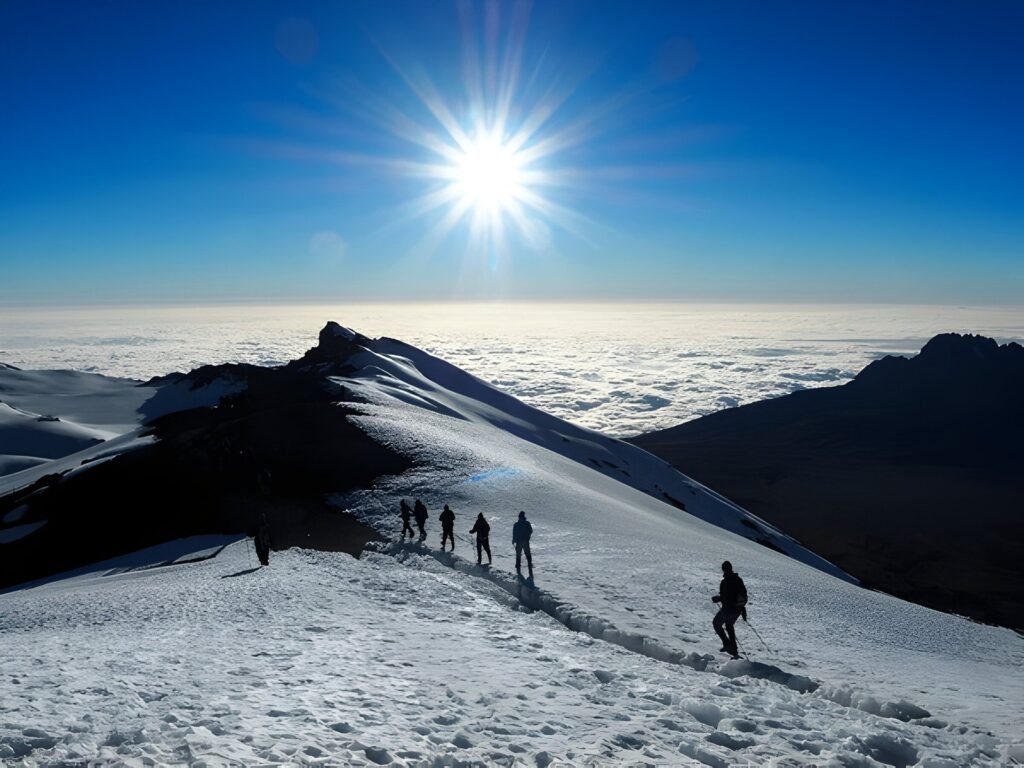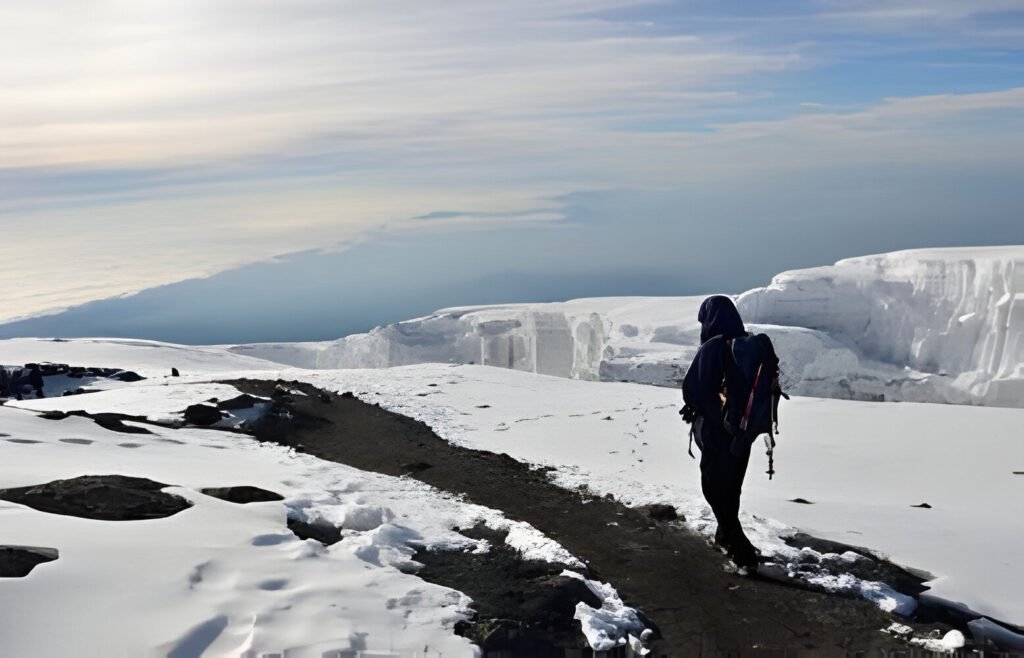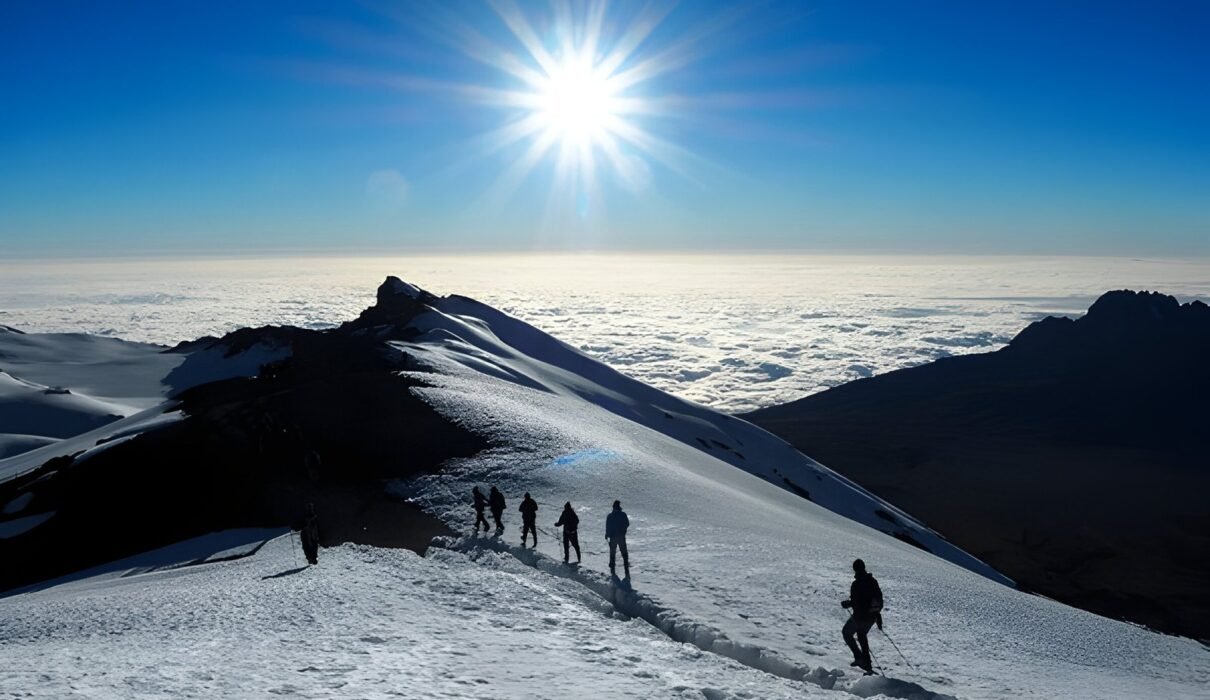Lemosho Route Kilimanjaro Climb Package : For those seeking a less crowded and more scenic journey to the summit of Mount Kilimanjaro, the Lemosho Route is the perfect option. Known for its panoramic views and rich diversity of ecosystems, this route provides a unique experience, from lush rainforests to barren alpine deserts. The 8-day Lemosho Route Kilimanjaro Climb Package offers the ideal balance between adventure and acclimatization, giving you ample time to adjust to the altitude while enjoying the breathtaking beauty of Kilimanjaro.
In this comprehensive guide, we’ll cover everything you need to know about the Lemosho Route and what’s included in this 8-day package, ensuring you’re fully prepared for your Kilimanjaro adventure in 2025.

Lemosho Route Kilimanjaro Climb Package : Why Choose ?
The Lemosho Route is often considered the most beautiful route to the summit of Uhuru Peak (5,895 meters), Africa’s highest point. Here are some key reasons why this route stands out:
1. High Summit Success Rate
Thanks to its longer itinerary, the Lemosho Route allows for better acclimatization, which significantly improves your chances of reaching the summit. With an average success rate of over 90%, this route is ideal for climbers who want a more leisurely pace and plenty of time to adjust to the altitude.
For more insights into acclimatization and how it affects your Kilimanjaro climb, check out this Harvard Health guide on altitude sickness.
2. Breathtaking Scenery and Diverse Ecosystems
One of the biggest draws of the Lemosho Route is its scenic diversity. Starting on the lush western side of the mountain, you’ll trek through rainforests, cross the stunning Shira Plateau, and climb to the dramatic Barranco Wall before making your way to the summit. Each day offers new and beautiful landscapes to enjoy.
- Rainforest Zone: Rich in wildlife, including monkeys and exotic birds.
- Moorland and Shira Plateau: Expansive, open landscapes with stunning views.
- Alpine Desert: A stark, high-altitude environment with panoramic vistas of Kilimanjaro.
For more information about the different ecosystems you’ll encounter, visit National Geographic’s Kilimanjaro guide.
3. Avoid the Crowds
Compared to other routes like Machame and Marangu, the Lemosho Route is less crowded, especially in the early stages. This allows for a more peaceful and intimate trekking experience, making it a great choice for those who want to enjoy the solitude of the wilderness.
Lemosho Route Kilimanjaro Climb Package : Day-by-Day Breakdown
The 8-day Lemosho Route package offers an ideal balance between acclimatization and adventure. Below is a detailed day-by-day itinerary for this route:
Day 1: Arrival in Moshi
Arrive in Moshi, where you’ll meet your expert guides and get a detailed briefing on the upcoming climb. Stay overnight at a comfortable hotel, preparing yourself for the adventure ahead.
To learn more about Moshi, the gateway to Kilimanjaro, visit Lonely Planet’s guide to Moshi.
Day 2: Londorossi Gate to Mti Mkubwa Camp (7 km)
- Elevation: 2,100 meters to 2,650 meters
- Trekking Time: 3-4 hours
Your trek begins at Londorossi Gate, where you’ll enter the rainforest and trek to Mti Mkubwa Camp. Keep an eye out for wildlife like Colobus monkeys as you make your way through the dense forest.
For more information on Kilimanjaro’s wildlife, check out the World Wildlife Fund’s profile on Kilimanjaro.
Day 3: Mti Mkubwa Camp to Shira 1 Camp (8 km)
- Elevation: 2,650 meters to 3,610 meters
- Trekking Time: 5-6 hours
You’ll leave the rainforest behind as you trek across the Shira Plateau, with stunning views of Kibo Peak in the distance. The day’s trek ends at Shira 1 Camp, where you’ll enjoy the wide-open vistas and clear night skies.
Day 4: Shira 1 Camp to Shira 2 Camp (6 km)
- Elevation: 3,610 meters to 3,850 meters
- Trekking Time: 3-4 hours
This is a shorter day, allowing more time to acclimatize. You’ll trek across the plateau, gradually gaining altitude as you head to Shira 2 Camp.
For tips on managing altitude during the climb, visit Altitude Research Center’s guide.
Day 5: Shira 2 Camp to Barranco Camp via Lava Tower (10 km)
- Elevation: 3,850 meters to 4,600 meters (Lava Tower), descending to 3,960 meters
- Trekking Time: 7-8 hours
This is a key acclimatization day. You’ll ascend to Lava Tower (4,600 meters) and then descend to Barranco Camp, following the “climb high, sleep low” principle. The descent to Barranco helps your body adjust to the altitude.
Day 6: Barranco Camp to Karanga Camp (5 km)
- Elevation: 3,960 meters to 4,035 meters
- Trekking Time: 4-5 hours
Today’s trek includes climbing the Barranco Wall, a non-technical but steep rock scramble that offers incredible views. After the climb, you’ll descend into the Karanga Valley before reaching Karanga Camp.
Day 7: Karanga Camp to Barafu Camp (4 km)
- Elevation: 4,035 meters to 4,673 meters
- Trekking Time: 3-4 hours
A relatively short trek leads to Barafu Camp, the final stop before the summit push. You’ll rest and prepare for the midnight ascent to the summit of Kilimanjaro.
Day 8: Barafu Camp to Uhuru Peak (5.7 km), Descend to Mweka Camp (12 km)
- Elevation: 4,673 meters to 5,895 meters (Uhuru Peak)
- Trekking Time: 12-14 hours (summit day)
Summit day begins at midnight, with a challenging trek to Uhuru Peak, the highest point in Africa. After celebrating at the summit, you’ll descend to Mweka Camp for the night.
For more on preparing for the summit push, read this expert guide on high-altitude trekking.
Lemosho Route Kilimanjaro Climb Package : What’s Included ?
The Lemosho Route 8-day package is designed to give you a seamless experience, covering everything you need for a successful and enjoyable climb:
1. Expert Guides and Porters
You’ll be led by certified, experienced guides who know the Lemosho Route intimately. Porters will carry your gear, ensuring you only need to trek with a light daypack.
For more about what guides and porters do on Kilimanjaro, check out Eddy Tours & Safaris.
2. Meals and Water
You’ll be provided with freshly prepared meals every day, along with ample drinking water to keep you hydrated during the trek.
3. Camping Equipment
High-quality tents, sleeping pads, and other camping equipment are provided to ensure you have a comfortable stay each night on the mountain.
4. Park Fees and Permits
All Kilimanjaro National Park fees and permits are included in your package, ensuring a hassle-free experience.
5. Transportation
Transportation from Moshi to the Londorossi Gate and back is included, providing a smooth and comfortable start and end to your adventure.
Learn more about Kilimanjaro National Park and its unique conservation efforts at UNESCO’s World Heritage site.
6. Safety Gear
Safety is paramount. Your package includes essential safety equipment such as oxygen tanks, first aid kits, and communication devices to ensure your well-being at high altitudes.
Lemosho Route Kilimanjaro Climb Package : Preparing for Your Lemosho Route Climb
1. Physical Training
The Lemosho Route requires good physical fitness. Focus on endurance activities like hiking, running, and strength training for your legs and core to prepare for the long days of trekking.
For a comprehensive training guide, check out Outside Online’s Kilimanjaro fitness tips.
2. Mental Preparation
Climbing Kilimanjaro is both physically and mentally challenging. Be prepared for summit night, which can be tough due to the cold, darkness, and altitude. A positive mindset and determination are key to reaching the summit.
3. Packing List
Packing the right gear is crucial for a successful climb. Be sure to bring:
- Sturdy hiking boots (broken in).
- Thermal layers to keep warm at higher altitudes.
- Waterproof jacket and pants.
- Trekking poles for stability on the steep sections.
- Sunscreen and sunglasses for UV protection at high altitudes.
For a complete packing list, visit Ultimate Kilimanjaro’s gear guide.

Lemosho Route Kilimanjaro Climb Package : Frequently Asked Questions (FAQs)
1. Is the Lemosho Route difficult?
The Lemosho Route is considered moderately difficult, with long trekking days and challenging terrain. However, its longer itinerary allows for better acclimatization, making it a great option for most climbers.
2. What is the success rate for the Lemosho Route?
The success rate for the Lemosho Route is over 90%, especially for the 8-day trek, which gives climbers plenty of time to acclimatize.
3. Do I need technical climbing skills for the Lemosho Route?
No, the Lemosho Route is a non-technical trek. You don’t need any technical climbing skills, but good physical fitness and mental endurance are important.
4. When is the best time to climb Kilimanjaro?
The best time to climb Kilimanjaro is during the dry seasons: January to March and June to October. These months offer the best weather conditions for trekking.
For more on Kilimanjaro’s climate, visit BBC’s Kilimanjaro weather guide.
5. Can I join a group climb on the Lemosho Route?
Yes, solo travelers can join a group climb, which is a great way to meet new people and share the adventure.
Lemosho Route Kilimanjaro Climb Package conclusion
For more information or to book your Lemosho Route Kilimanjaro Climb Package, visit Kilimanjaro Climb Specialist and Eddy Tours & Safaris.

